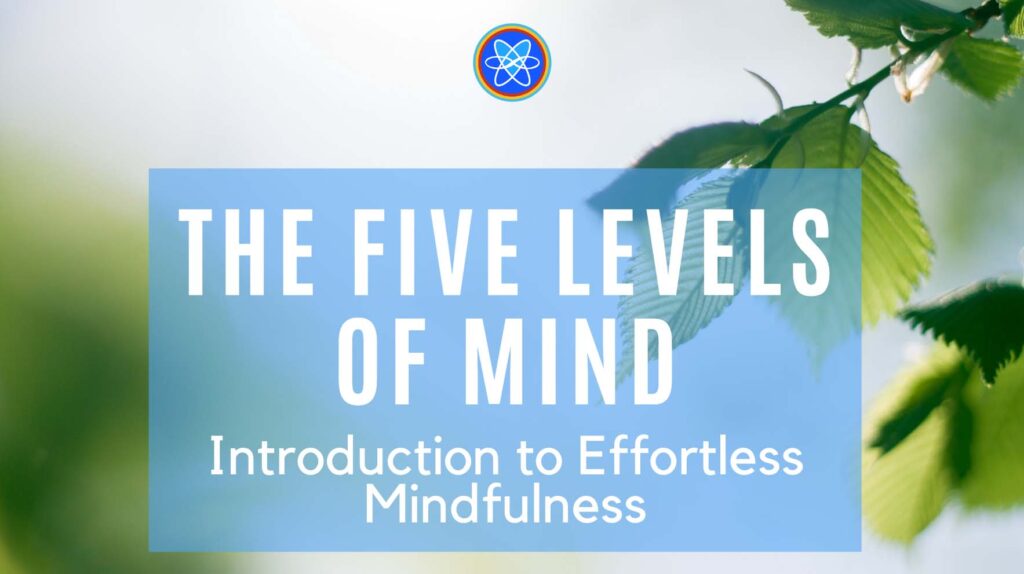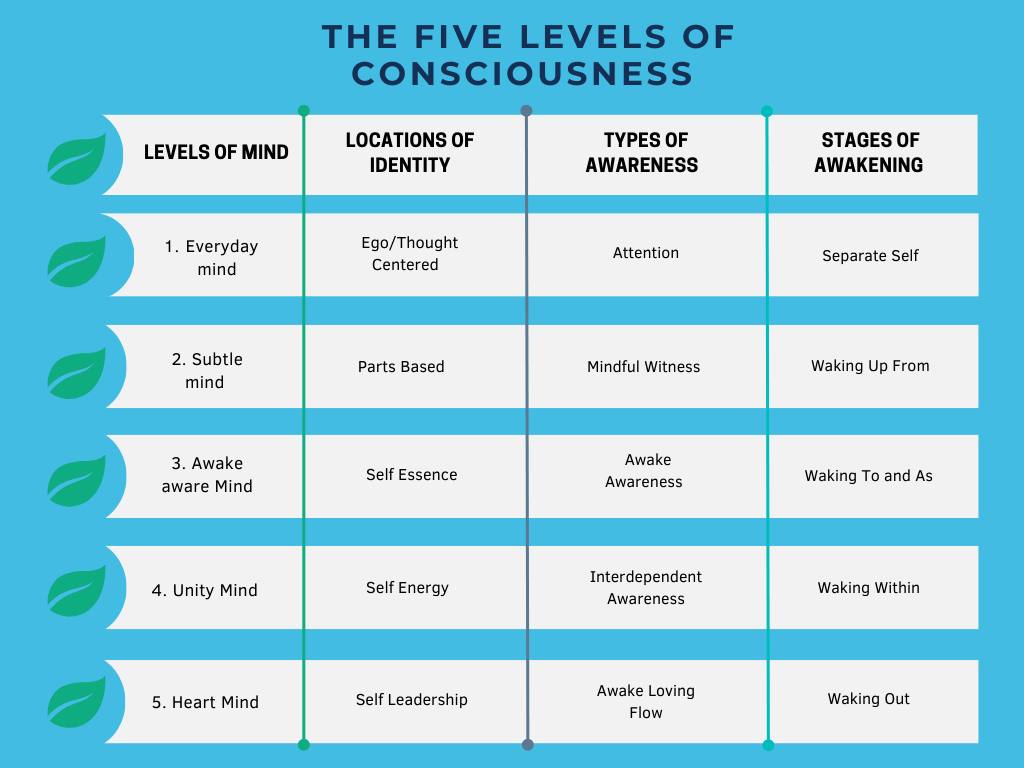
Every great meditative tradition the world over has major maps of the significant steps or stages in meditation as their tradition has come to understand and practice them. And what significant research has demonstrated is that virtually all of them follow the four or five major natural states of consciousness given cross-culturally and universally to all human beings. ~ Ken Wilber, Philosopher and Author
Most of us live as if we have just one mind—the ordinary everyday mind we use to navigate our world.
But did you know that there are actually 5 levels of consciousness (I call them the Five Levels of Mind) that move along a spectrum from gross to infinitely subtle and then back again? And that those levels of awareness include all dimensions of our mind and body?
If you’re interested in healing and growth, it’s important to understand this. Because how we experience our lives is fundamentally shaped by the level of awareness we’re rooted in at any given moment.
It’s probably no surprise to you to learn that most of us live in our everyday mind. We’re stuck in an old model, believing “I think therefore I am.” You’ll see in a moment that this is not our only option.
A Different Way To Live
There’s actually a different way to live, where we’re not trapped in the mundane level of thinking about thinking or lost worrying about the next thing that might happen.
In the Effortless Mindfulness Awakening Process (EMAP), there’s a map, a method, and markers. And one of the main maps in this model is the Five Levels of Mind, which outlines these distinct levels of awareness.
Using this map, you can learn to access all 5 levels of consciousness. In fact, with practice, you can shift through them faster than thought and at will. Indeed, the five levels of mind are inherent within us right now. You don’t need to cultivate or generate them.
They’re always here.
In addition to showing us how we progress through these layers of consciousness, the Five Levels of Mind helps us identify exactly where we’re rooted in that map of consciousness at any given moment.
And as I’ll share with you in a moment, having such a map is incredibly helpful in your hero’s journey of healing, growth, and fruition.
Join Loch Kelly for a deep dive into the Five Levels of Mind
5 Levels of Consciousness
But first, what are the Five Levels of Mind and how do you move through them? And what are the benefits of each?
Let me take you on a brief tour through these different levels of awareness. They’re called everyday mind, subtle mind, awake aware mind, unity mind, and the one that includes all other minds—the heartmind.
Let’s unpack this and explore the attributes and character of each of the Five Levels of Mind.
1. Everyday Mind
The first one we know very well, and we can call it Everyday Mind.
This level of mind is our thought-based mind. First, it includes our development from pre-verbal infant dependent on adults to conceptual-thinking child. At that point, we become independent as we learn to think and discern on our own. And then we individuate, creating an identity through our conceptual and thought-based mind: “I think, therefore I am.”
In Tibetan, this thinking mind is called “sem,” small mind, or thought-based mind. It includes our normal sense of self and our inner constellation of thoughts, feelings, sensations, and orientation to our body as a separate object.
For many of us, the journey through the 5 levels of consciousness stops here, in the cul de sac of our miraculous but limited conceptual mind. At best, we get intimations of another possibility—higher levels of awareness—through dreams or occasional flow states when we temporarily transcend our everyday mind while immersed in an activity or nature.
2. Subtle Mind
Subtle Mind is the second level of awareness, and it includes subtle body energy. We often experience the subtle mind during mindfulness practice. For example, if we’re resting our attention on the breath as our meditation object, we start this process grounded in our everyday mind.
But then we shift up and realize that we are experiencing the focuser—which felt solid and separate in our everyday mind—as a dynamic field of pixelated thoughts, feelings, and sensations.
So what was previously the Thinker is now experienced as an ever-shifting montage of thoughts that are coming and going. And there’s no longer that feeling of a solid and separate sense of self.
Instead, there’s a witness consciousness which enables us to step out and notice that we’re no longer trapped in our gross everyday mind (sometimes referred to as the causal mind).
But it doesn’t stop there. We also have a subtle body, which is part of the subtle mind.
As we use our subtle mind to look within, we not only see that our solid and separate sense of self is an ever-changing dynamic field of thought, but we also feel our body as an energetic system of space and energy.
Our bodies, once so solid and weighty, start to feel like an effervescent cloud of subtle sensation.
In fact, many traditional systems of meditation, yoga, and Qigong focus on the everyday mind and subtle mind. Psychology, too, looks at both.
First, everyday mind, where we have different moods and emotions. And second, the subtle mind, where we start to see different parts of ourselves (subpersonalities) arise. But now we are no longer embedded in those parts. We start to see them from a distinct vantage point, un-blending and detaching from them via the mindful witness.
In the subtle mind, the liberating power of our metacognition really comes online and sets the stage for a much greater shift in awareness.
3. Awake Aware Mind
In the next stage, we inquire into what is behind the mindful witness. What is present that is even deeper and subtler than the mindful witness?
Here we discover the layer of consciousness that I call Awake Aware Mind. And Awake Aware Mind is not just pulling back the camera further and further to a bird’s eye view of Big Sky mind, choiceless awareness, or witness consciousness.
Instead, it means looking back through, or opening up to, that which is spacious and pervasive. To make this more concrete, you can imagine the Awake Aware Mind as the sky of awareness that permeates the cloud.
And among the different levels of awareness, this one highlights the discovery of an effortless awareness that we did not know was available. That’s why I use the term Effortless Mindfulness.
Why? Because the word effortless refers not to the absence of effort, but to the discovery of this already awake and aware mind.
You see! Awake Aware Mind is already alert. It’s already here, without concentration or focus from the small mind. You don’t have to build any new concentration muscles or rehearse mystical mantras to generate a meditation trance.
Instead, you simply shift your perspective. As we progress through the 5 levels of consciousness, everything flows from this one simple shift.
4. Unity Mind
I call the fourth stage of consciousness Unity Mind. Sometimes this is referred to as nondual mind, simultaneous mind, or same taste. This means that we’re now rooted in a level of awareness that isn’t separate from the aliveness—aka the kaleidoscope of everything we experience, inner and outer, all the time. Aliveness means the world of all phenomena.
At this level of awareness, I’m pointing to a dramatic shift in perspective. You no longer experience anything (or anyone) as separate from you and feel a fundamental kinship with all creation.
Immersed in Unity Mind, you’re aware of your body and the world, and any movement, as a simultaneous pair of awareness and aliveness or emptiness and appearance. And that is an experience, not a philosophy.
So the feeling is complete embodiment and interconnection. It’s the interdependent awareness that Thich Nhat Hanh famously referred to as Interbeing.
This simultaneous mind is the feeling of nondual presence. You feel safe, connected, embodied, and yet boundlessly filled with a sense of buoyant support. Here, at last, that nagging feeling of fundamental separateness slips away. And at the same time, we maintain our sense of a separate body in relation to others.
So this level of mind is both spacious and pervasive while maintaining a multi-dimensional and unique expression.
As I mentioned above, the metaphor for the Awake Aware Mind is the sky of awareness that permeates the cloud.
With Unity Mind, the image is the ocean of awareness. The ocean arises as unique waves of me and you. It’s the same ocean of consciousness, and yet distinct waves arise from that one oceanic source as particular beings.
We are distinct but not different.
Want to learn more? Join Loch Kelly and experience the Five Levels of Mind for yourself.
>> Learn More about the Effortless Mindfulness Level One training course
5. Heartmind
The fifth level of mind is Heartmind. Sometimes you’ll hear it referred to as bodhichitta, which means awake consciousness that has a natural arising compassion.
When we’re in unity mind, we feel interconnected. We feel the same as everyone and everything. This profound shift engenders the arising of natural compassion.
From here, the heartmind feels like we’ve dropped out of the physical and mental center of our head and into our whole body and the interconnected field of awareness. In that space, we create and relate rooted in a feeling of effortless safety, service, and compassionate clarity.
In the heartmind, we don’t just sit quietly in a meditative state. Rather, we feel like there’s an inner fountain of fullness and openness. Once we go from Awake Aware Mind to Unity Mind and then Heartmind, we’re imbued with insight into who we are as the very fabric of the universe. Overflowing with purpose and wholeness, we don’t feel anxiety, worry, or even fear of death.
Instead, we experience deep resonance and gratitude for this precious human life. At peace with an imperfect human personality, we’re willing to do service with compassion and creativity, relishing our vivid connection with others.
A New Operating System for an Optimal and Connected Life
So these are the 5 levels of consciousness that we navigate when we embrace Effortless Mindfulness. And to be clear, as the Ken Wilber quote alludes to above, I didn’t make these up. These 5 levels are universal, but I have my own interpretation and expression of them.
In time and with practice, you can learn how to shift through these levels of awareness at will.
And as you become sensitive to and familiar with each level of awareness, you’ll experience a new ground of being as your basis of being. You could even say that it’s like a new operating system. And each stage will feel like your new homebase.






